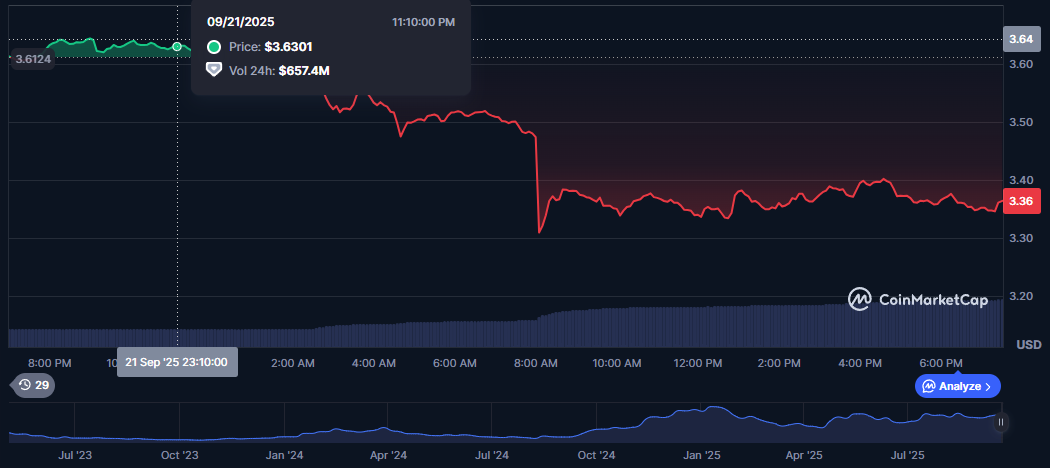SUI Holds $3.67 While Digitap Emerges As Best Crypto To Buy Now For Real-World Spending
Crypto often moves with trending tokens, and right now SUI is one of them. The token has hit $3.67, keeping traders focused on its next move. At the same time, another project is rising during its presale. Digitap ($TAP) is positioning itself as a token designed for real-world spending, not just trading charts.
This makes for an interesting comparison. One project is riding current market cycles, while the other is offering an early entry into a platform built for practical use. The balance of hype versus utility defines much of today’s crypto discussion, and Digitap seems to be the token that tips that balance.
SUI Holds Its Ground, But For How Long?
SUI has attracted strong trading interest since its launch. The project promotes a high-performance blockchain that can handle complex transactions with low fees. This has helped SUI build a following in DeFi and other fast-moving parts of crypto.
However, SUI’s story remains focused on trading metrics. Its value is linked to activity within its ecosystem and the pace of development on its blockchain. While this gives it momentum, it also ties its outlook to the unpredictable swings of market cycles. That leaves open the question of how much long-term utility will drive demand.
Some observers believe that SUI must prove it can support applications with real-world use if it wants to keep its place among leading tokens. Without broader adoption beyond trading and DeFi, its future could depend too heavily on market sentiment rather than consistent utility.

Source: CoinmarketCap/SUI
Why Digitap Is the Money App of Tomorrow
Digitap takes a different angle. Instead of building a high-speed blockchain for developers, the team is building a platform for everyday spending. The vision is simple: one app and one card that handles both fiat and crypto.
Digitap aims to let users spend any supported crypto or cash instantly, anywhere Visa is accepted. It will also offer both physical and virtual cards, integration with Apple Pay and Google Pay, and even custom card designs. All of this is meant to make crypto as easy to use as cash in daily life.
Privacy is another key point. Digitap is designed with non-KYC cards, anonymous virtual cards, and offshore account structures for asset protection. This approach appeals to users who want financial freedom without constant tracking.
While many projects compete on speed or new technology, Digitap aims to make crypto practical for real-world payments. It is not only about trading but also about buying groceries, booking travel, and paying freelancers – all with the same token ecosystem.

A $150K Presale That Could Redefine Utility
The presale adds another layer of interest. $TAP, the native token, comes with a fixed supply of two billion. There is no hidden inflation, no buy or sell tax, and a deflationary burn model. As the ecosystem grows, the $TAP supply is designed to shrink over time. The presale has already surpassed $150,000, demonstrating early momentum from buyers eager to secure their position before exchange listings.
Rewards are also structured to attract early adopters. Presale staking offers up to 124% APR, with long-term staking after launch still offering up to 100%. Unlike many inflationary models, these rewards come from a fixed pool, which protects long-term token value.
This is where the contrast is strongest. SUI is established but now tied to market cycles, while Digitap is just starting and offers exposure at the earliest stage of its journey. For those looking at utility combined with early entry, the presale gives Digitap an edge. A small increase in demand can lead to far larger percentage gains for early holders.

Why Digitap May Outlast the Market Cycle
SUI shows strength as a trading token, but its outlook depends heavily on blockchain development and the mood of the market. Its path is likely to reflect the ups and downs of wider crypto cycles.
Digitap, on the other hand, is building for real-world spending with a product that targets everyday use. Its focus on privacy, cards, and simple crypto-to-fiat spending sets it apart. The catalysts for Digitap such as Visa card integration and continuous token burns could support long-term value in a way that pure trading tokens struggle to deliver.
For those watching the market, Digitap makes the case that the next big opportunity may not come from chasing today’s trending chart but from backing a token designed for everyday spending.
Discover how Digitap is unifying cash and crypto by checking out their project here:
Presale https://presale.digitap.app
Social: https://linktr.ee/digitap.app
Disclaimer: This is a paid post and should not be treated as news/advice. LiveBitcoinNews is not responsible for any loss or damage resulting from the content, products, or services referenced in this press release.
The post SUI Holds $3.67 While Digitap Emerges As Best Crypto To Buy Now For Real-World Spending appeared first on Live Bitcoin News.
You May Also Like

Aster's 24-hour revenue surpasses Circle and is second only to Tether

Tether's value surges over 40-fold, with a $500 billion valuation hinting at both capital and narrative ambitions.
